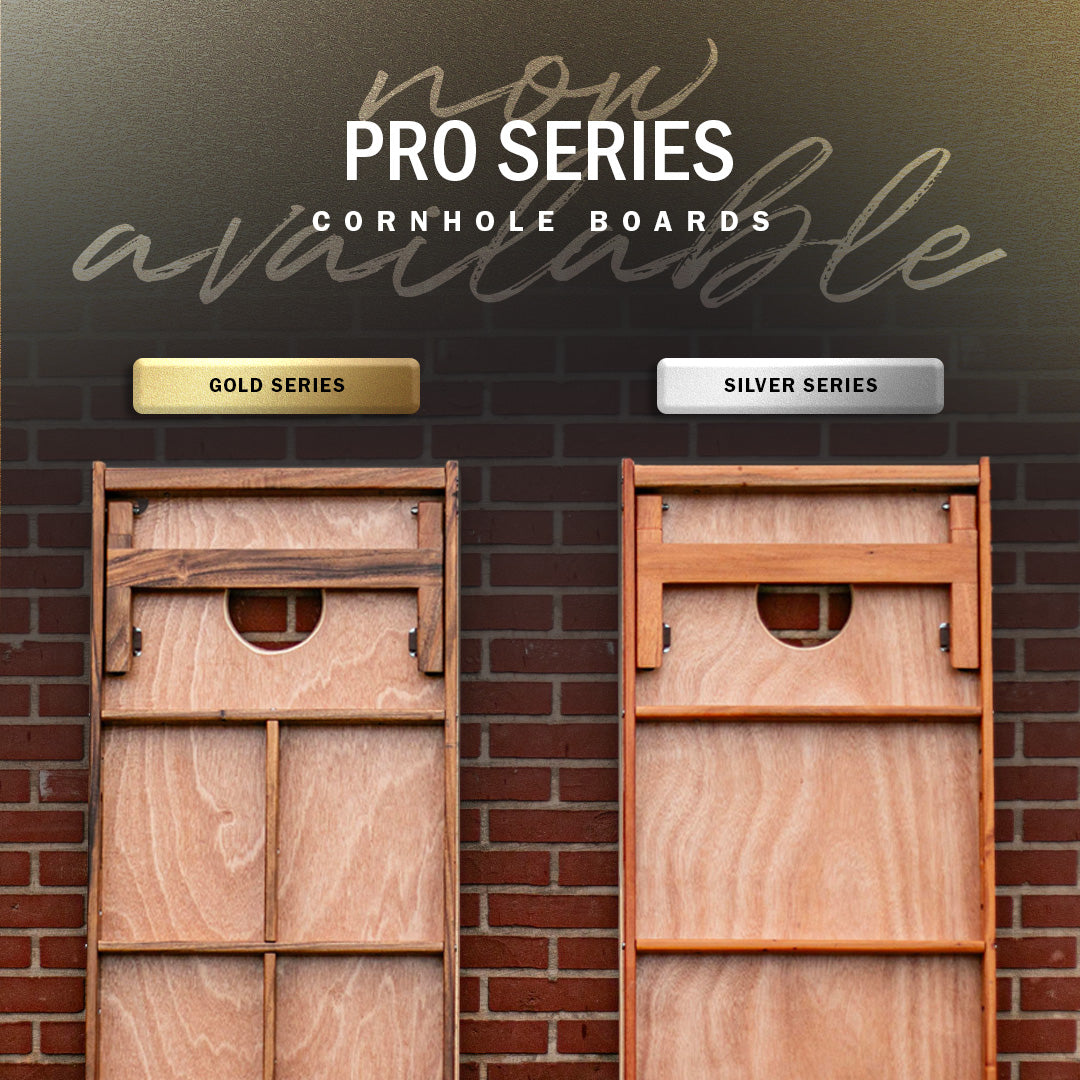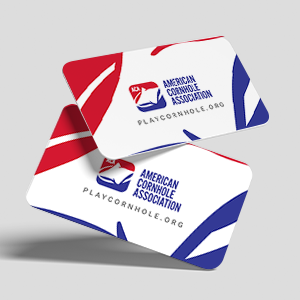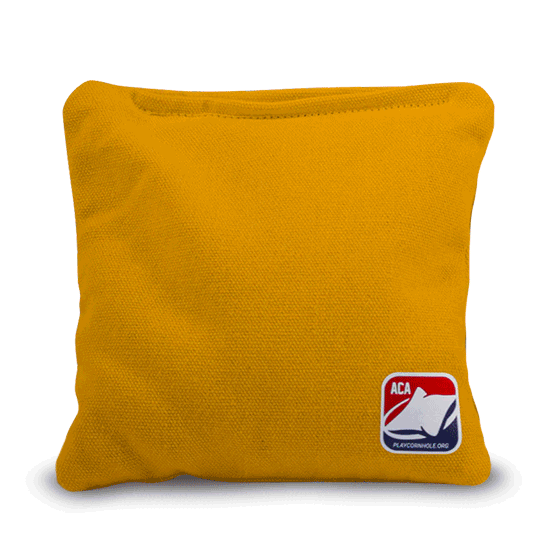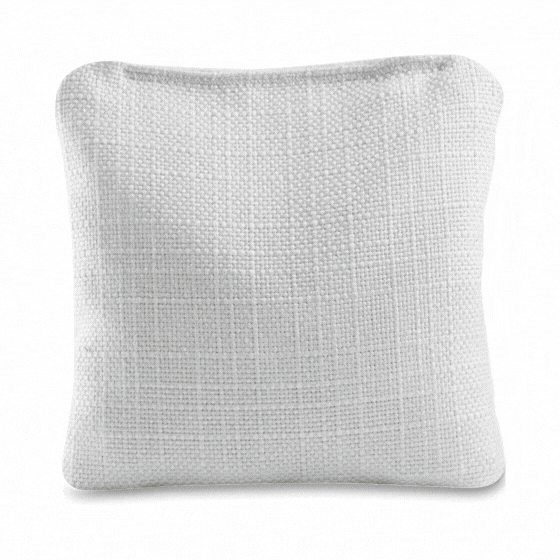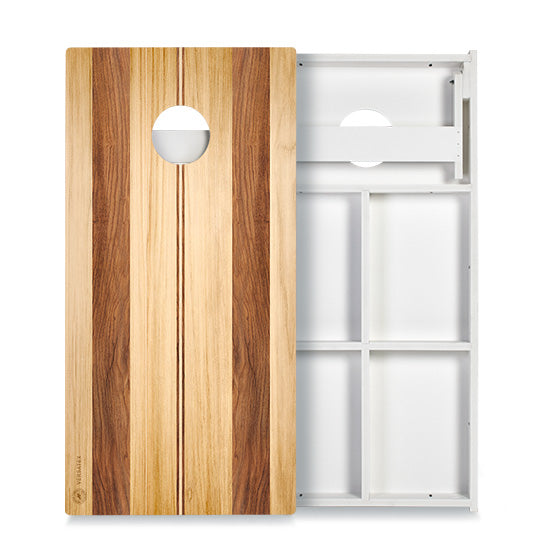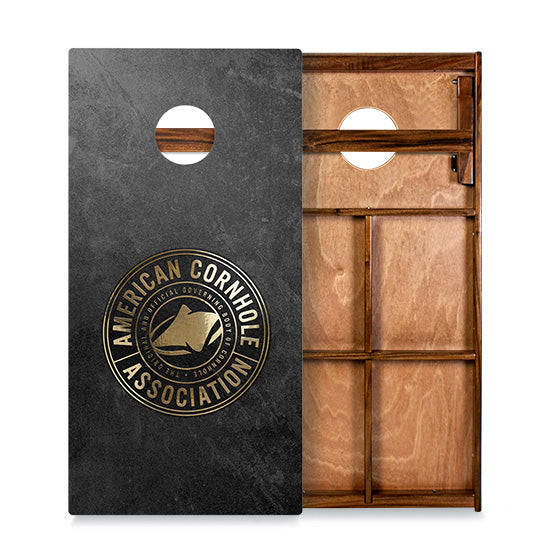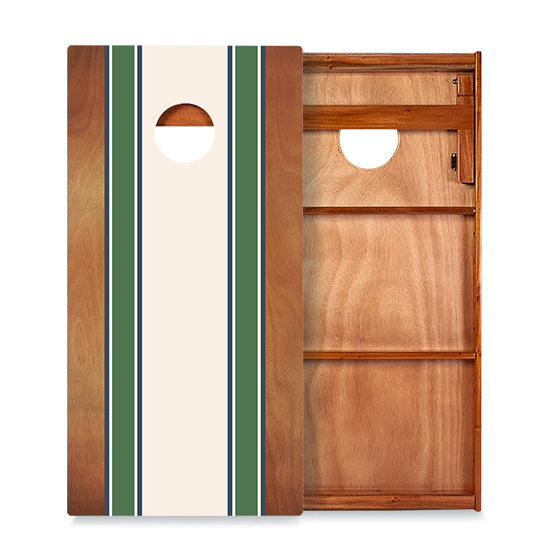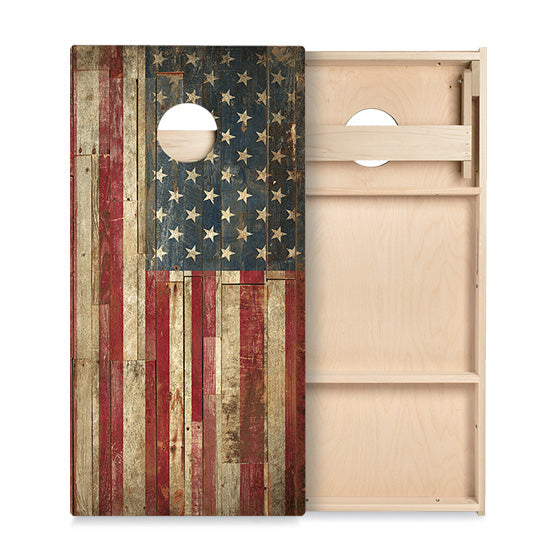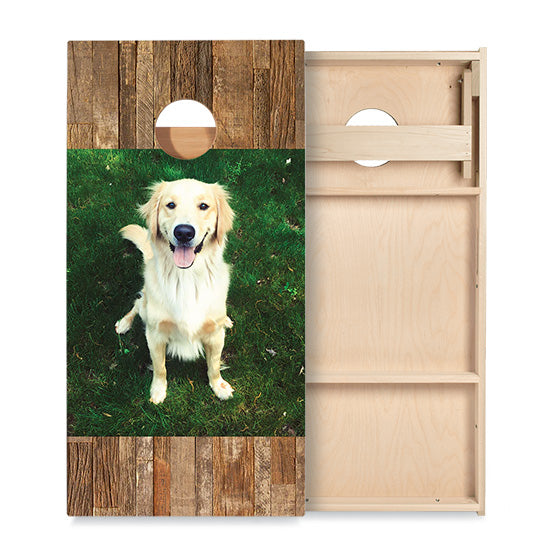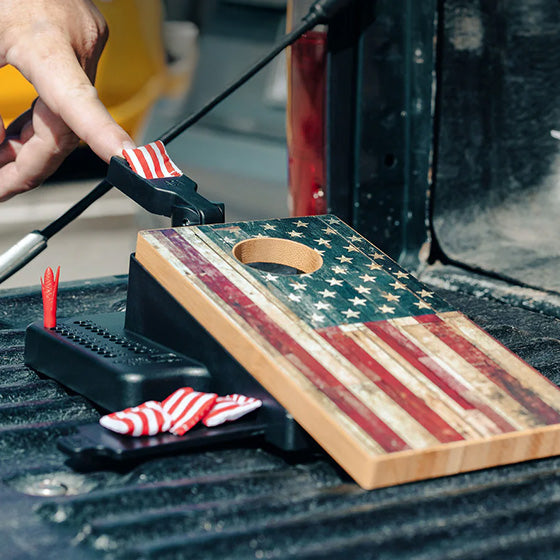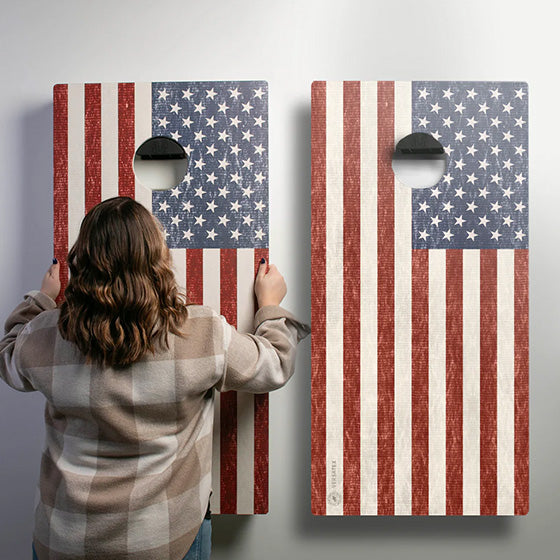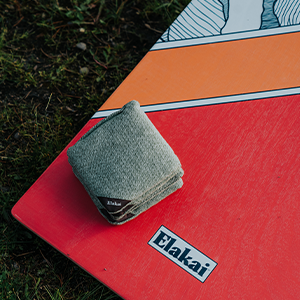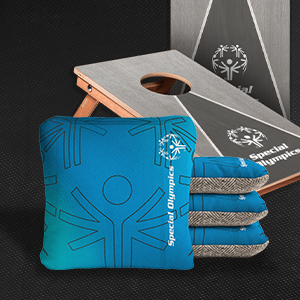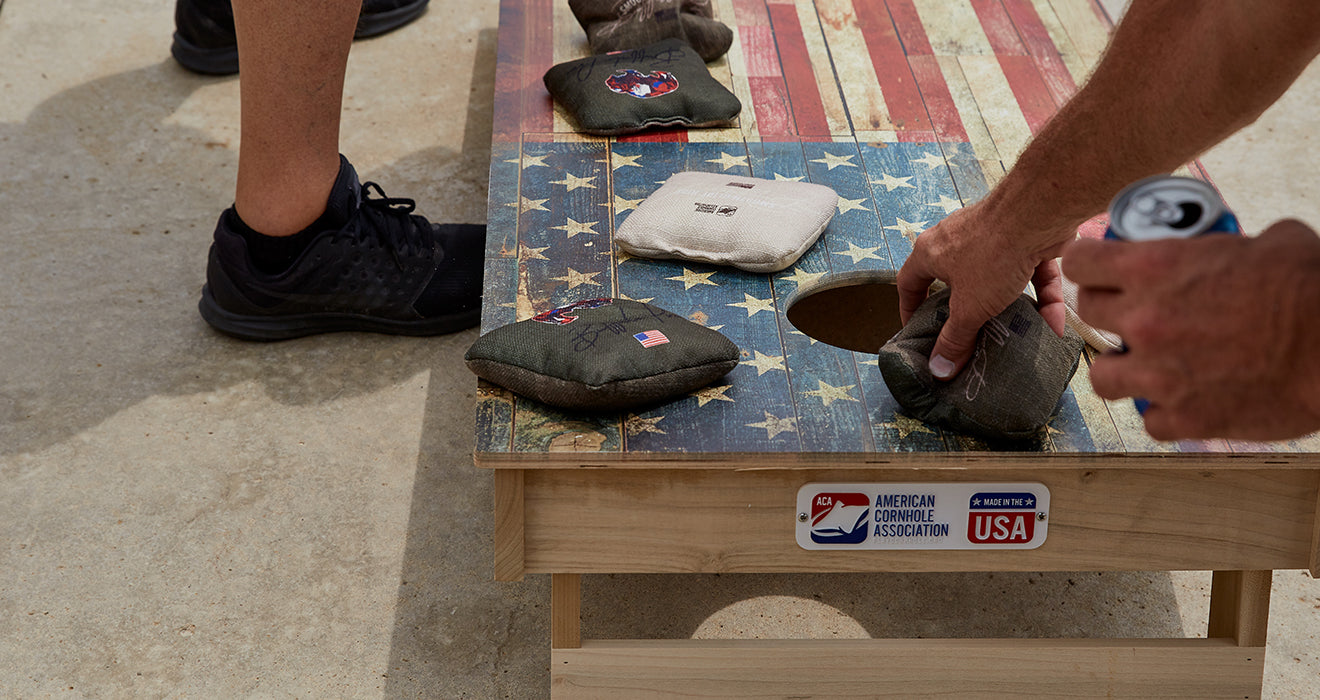HOW TO PLAY CORNHOLE
The following video and written guidelines are the original and official rules of cornhole and intended for recreational game play, professional cornhole competitions, and ACA tournaments.
Friends don't let friends (opponents) break the rules. Send the official rules of cornhole to all of your rule breaking buddies!
How to Play Cornhole
The Basic Rules of How to Play Cornhole
Cornhole is played with two or four players attempting to toss cornhole bags into the hole on a cornhole board to score points.
Objective
Be the first team to reach (or exceed) a score of 21 points at the end of an inning of play.
Cornhole Equipment
- Cornhole Boards: Standard cornhole boards are 2-ft. x 4-ft. The hole is positioned 9-in. from the top of the board, with a 6-in diameter.
- Cornhole Bags: Each team has four cornhole bags of contrasting colors. Cornhole bags should be 6-in x 6-in. and weigh approximately 1 pound.
Cornhole Board Distance
Cornhole board distance: The cornhole boards are placed 27 feet apart from front edge to front edge.
- Kids, seniors, or physically impaired adults may want to move the board closer together, at 12-15 feet.
Cornhole Rules
- Cornhole is played with two teams, each consisting of one player (singles) or two players (doubles).
- Players pitch their bags in an underhand motion from the pitcher's box next to each side of the board.
- Players alternate turns tossing their cornhole bags toward the opposite board.
- After each team has pitched four bags, players take score, and resume pitching to the opposite board.
- The team who scored points in the previous inning goes first in the next inning. If it was tied, the team who went first in the last inning gets to go first again.
Cornhole Scoring
- A cornhole bag that goes through the hole is worth 3 points.
- A cornhole bag that lands on the board and stays there is worth 1 point.
- A cornhole bag that lands on the ground or bounces onto the board is worth 0 points.
- Cancellation Scoring: Only one team can score points per inning. The team with the higher score cancels out the points of the opposing team in that inning.
- Points Calculation: The team with the higher score in an inning earns the difference in points. For instance, if Team A scores 5 points and Team B scores 2 points in an inning, Team A earns 3 points for that inning.
Winning the Game
A The first player or team to reach or exceed 21 points at the conclusion of an inning is the winner.
The Official Rules of Cornhole | Full Cornhole Rules
How to Play Cornhole | The Court
Court Layout
The following dimensions and measurements serve to determine how far apart to place cornhole boards as well as the positioning of players during gameplay.
Court Dimensions
A cornhole court shall be a level rectangular area 10-12 feet wide and a minimum of 40-45 feet long. The court consists of two cornhole boards, designated pitcher's boxes, and foul lines.
Pitcher's Box
The pitcher's box is a rectangle 4 feet by 3 feet at each end of the court, parallel with, and on both sides of the boards. Each player must remain in the pitcher's box while pitching a cornhole bag.
Foul Lines
There are two sets of foul lines: open adult play and junior play for children 12 and under. The adult foul lines shall be defined as an imaginary line 27 feet between the front of each board. The junior-play foul lines shall be defined as an imaginary line 12-15 between the front of each board. Physically impaired adults or seniors may observe the 12-15 foot foul lines if agreed by all contestants. The foul line should be parallel to the front of the opposite board to meet ACA guidelines.
Vertical Clearance
Indoor or covered cornhole courts shall have a minimum 12-foot vertical clearance to the lowest possible obstruction.
Multiple Courts
To eliminate distraction and safely separate activity, cornhole courts adjacent to each other shall be a minimum of 10 feet wide. A greater distance of at least 12 feet is preferable.
A full cornhole court setup
How to Play Cornhole | Equipment Standards
Cornhole Boards
OFFICIAL SPECIFICATION STANDARDS
- The following dimensions and measurements serve to determine standards and specifications for regulation cornhole boards.
- Each cornhole board shall be 47½ to 48 inches long and 23½ to 24 inches wide, made of smooth plywood that measures at least ½-inch in thickness.
- Cornhole boards should be comprised of a wood surface and a wood frame. There is significant variance in play between wood and plastic or other surfaces.
- The hole in each cornhole board shall be 6 inches (+-¼-in) in diameter. Its center shall be 9 inches (+-¼-in) from the top and 12 inches (+-¼- in) from each side of the board edges.
- The front of the cornhole board shall be 3-4 inches from bottom to top.
- The back of the cornhole board shall be approximately 12 inches (+- ¼-in) from the ground to the highest point of the deck.
- The board finish shall be sanded to a very smooth texture, and there shall not be any blemishes in the wood surface that might disrupt or distort play.
- Application of non-permanent foreign substances onto cornhole boards is strictly prohibited. This includes talc, resin, spray, or powders.
Cornhole Bags
OFFICIAL SPECIFICATION STANDARDS
- The following dimensions and measurements serve to determine standards and specifications for regulation cornhole bags.
- The cornhole bags shall be made from two fabric squares 6¼ x 6¼ inches with a ¼-inch stitched seam on all four sides.
- Bags should be made from durable fabric.
- The thickness of the bag, when lying flat on a hard surface, should be approximately 1 inch (+-⅛-in) thick.
- Each bag shall be filled with plastic pellets or corn feed. Finished bags should be roughly 6 inches square and weigh 14-16.25 ounces.
- All bags in a set of four shall be identical in color, design, and pattern.
-
A player may not switch bags during gameplay unless a bag is damaged or broken during a game.
- In the case of a broken bag during a game, a player/team may substitute an identical or equivalent set of 4 bags.
- In the case of a broken bag during a game, a player/team may substitute an identical or equivalent set of 4 bags.
How to Play Cornhole | Scoring
Pregame Coin Toss
- Prior to beginning the game, a coin toss will determine playing lanes and sequence of play.
- The team that wins the coin flip will choose either their throwing lane or the throwing order in the first inning of play.
- The team that did not win the coin flip chooses the remaining option.
Play of the Game
An inning is completed when both players, pitching from one board, pitch all eight bags (four each).
Singles Cornhole Matches
Two single players compete against one another until a single winner is determined.
- Both players stay in their designated lane for the whole game.
- Players start the game at the headboard and alternate pitching bags until each player has pitched all four of their bags.
- Players then walk to the end of their lane to the other court, take score, and resume pitching back to the other board.
Doubles Cornhole Matches
Two teams, consisting of two players, compete against one another until a winning team is determined.
- Each team will stay in their designated lane for the whole game.
- Players line up directly across from their playing teammate in the same lane.
- Players at the headboard alternate pitching bags until each player has pitched all four of his/her bags.
- Players at the footboard take score and resume pitching back to the other board.
Scoring
The approved method of scoring for the sport of cornhole is cancellation scoring. In cancellation scoring, the points of one player cancel out the points of their opponent. Using this method, only one player/team can score in each inning.
- Bag In-The-Count (Woody): Any bag which comes to rest anywhere on top of the board. Each is worth one (1) point.
- Bag In-The-Hole (Cornhole): Any bag which is thrown through the hole or knocked through the hole by another bag. Each is worth three (3) points.
- Foul Bags: Refers to any bag that was designated a foul bag as the result of a rules violation. Each is worth zero (0) points.
- Dead Bags: Refers to any bag that contacted the court or the ground before coming to rest on the board or any bag that struck a previously defined object such as a tree limb, wire, indoor court ceiling, etc. Each is worth zero (0) points.
Pitching
- The player or team who scored in the preceding inning has the honor of pitching first in the next inning. If neither player or team scores, the player or team who pitched first in the preceding frame shall retain the first pitch in the next frame.
- The pitcher must be within their designated pitcher's box or behind the foul line at the time of release.
- A player must pitch all four bags from their designated pitcher's box.
- Players must pitch the bag with an underhand release.
- A player may not step over or contact the foul line while pitching or releasing a cornhole bag.
- A player must wait until the previous bag has come to a complete stop for at least 2 seconds before pitching the next bag.
- Players may not jump, blow, kick, or otherwise do anything that may affect the cornhole board and the positioning of bags during an inning.
- Touching, adjusting, or aligning a cornhole board during an inning is prohibited. Players or officials may only align the cornhole board between innings.
- A contestant must pitch the entire match with the same hand or arm, except in the case of a medical emergency.
Foul Bag Rule Violations
Foul bags and rules violations are divided into impacting fouls and non-impacting fouls. A court official is responsible for spotting and calling penalties. The players or court official must determine if a foul bag was impacting or non-impacting.
Non-Impacting Bag Violation
- If a bag in question does not impact gameplay or any other bag in play, it is a non-impacting bag violation.
- The bag is considered dead and is removed from play at the time of infraction. This bag scores 0 points for the inning. All other bags remain in play. No other movement of bags is permitted at this time.
Impacting Bag Violation
- If the bag in question impacts the position of one or more bags in play, it is an impacting bag foul.
- Leave the bag in question and all affected bags in play. Continue the game until the end of the half-inning without touching or removing any bags.
-
At the end of the half-inning, the team that threw the offending bag removes the highest-value bag in play from the scoring calculation.
-
Example: Team A steps over the line during their 3rd toss of the inning. The offending bag knocks a bag from Team B off the board. Bags are not replaced or affected at this time. At the end of the inning, subtract the highest-scoring bag from Team A from the scoring calculation.
- If 0 points were scored for Team A in the inning, no scoring updates are made.
-
Example: Team A steps over the line during their 3rd toss of the inning. The offending bag knocks a bag from Team B off the board. Bags are not replaced or affected at this time. At the end of the inning, subtract the highest-scoring bag from Team A from the scoring calculation.
List of Fouls
The following are foul violations that must be spotted and called by an assigned judge. A foul is assessed to the offending team.
- Any bag pitched when the player has made contact with or crossed over the foul line.
- Any bag pitched when the player has started or stepped completely outside the pitcher’s box before the bag is released.
- Any bag not delivered within the 20-second time limit.
- Any bag pitched from a different pitcher’s box than the first bag.
- Any bag that is not pitched with an underhand release.
Interrupting Gameplay
A player shall not touch, alter, move, or affect the board or any bags on the board or in the hole before scoring has been agreed upon for the inning.
- If this foul occurs during play, please refer to IMPACTING BAG section above.
- If this foul occurs at the conclusion of an inning, and before the score is taken, the non-offending team receives 3 points for each bag removed prior to scoring confirmation.
Dead Bags
Any bag that contacted the court or the ground before coming to rest on the board shall be ruled a dead bag.
Any bag that struck a previously defined object such as a tree limb, wire, indoor court ceiling, etc. shall be ruled a dead bag.
- Immediately remove the bag from play and continue the inning. The offending team is not assessed any penalty or foul.
- If the bag impacts another bag, remove the offending bag where it lies and leave the remaining bags as they lie and continue play. The offending team is not assessed any penalty or foul.
Additional Foul Rules
A bag that leaves a player’s hand once the final forward swing of the delivery process has started shall count as a pitched bag.
A bag that is accidentally dropped by a player before the final forward swing has started shall not be considered foul and may be picked up and pitched.
If players believe they have thrown all bags, clear the board for the next inning, but then realize they missed one bag, the inning ends. Points are scored as if the inning ended, and the missed bag is forfeited.
Any action or intentional use of a penalty that undermines the integrity of the game, as determined by the court official, will result in the player's disqualification and forfeiture of the match.
Protests
If a player desires to make a protest, the protest shall be made to the judge or official at the time the problem occurs. The judge shall make the final ruling on all protests.
Disqualification
- Purposely interfering with an opponent's pitching motion will disqualify a player and result in forfeiture of the game.
- Any act deemed excessively poor sportsmanship will disqualify a player and result in forfeiture of the game.
Determining Winners - Traditional 21
The game shall be played to the predetermined number of twenty-one points. The first player/team to reach (or exceed) that amount at the conclusion of an inning is the winner.
FOR MORE RULES & WAYS TO PLAY
THE ULTIMATE CORNHOLE GUIDE PLAYBOOOK
Download the ACA's FREE Ultimate Guide to Cornhole Playbook! This printer-friendly guide gives you all the rules to cornhole and more.
THE OFFICIAL ACA CORNHOLE SHOP
Grab your official ACA cornhole boards, cornhole bags, games, and accessories.
View the entire product selection from ACA.

